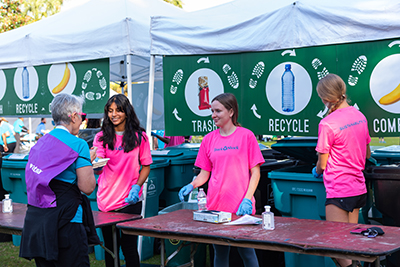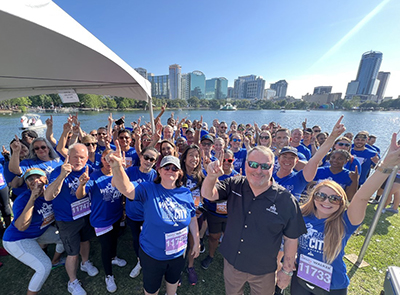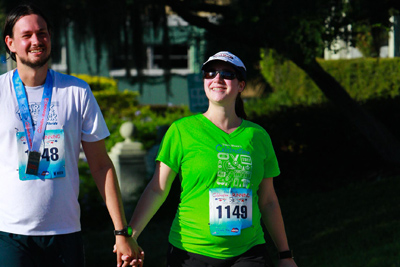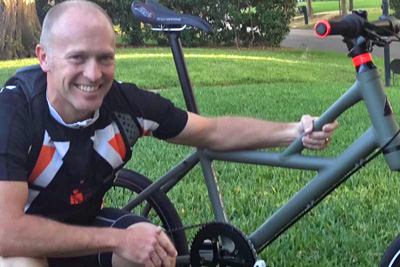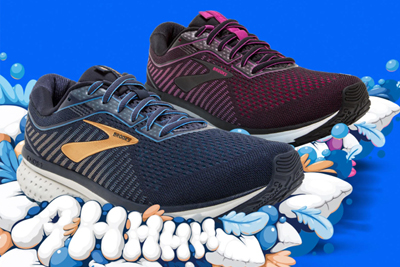Tips for Runners by Susan S. Paul, MS, TSF Training Program Director
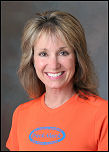
TIP #1: RACE DAY- Stick to your routine!
Sticking to your routine means doing EVERYTHING as close to your normal routine as possible. Eat the same foods you ate during training the entire day before your event AND the morning of your event. Only wear shoes and clothing you have already worn and that you know do not rub or chafe you. Use the same energy supplements, at the same time or mileage intervals, you used during your training. Do NOT deviate now! Go to bed and arise at your usual sleep times if at all possible. Getting a good night sleep two nights before the race is more important than the night before. Most of us do not sleep well the night before our event, but don’t worry, because studies have shown that loss of sleep the night before a race does not impact performance. Experiencing some level of race anxiety is very normal; in fact, some race anxiety actually boosts performance, so learn to feel comfortable with a few butterflies!
Race Expos always have wonderful stuff; usually the latest and greatest in running gear. Shopping is fine, buy all you want; but remember using a brand new item on race day is not a good idea. Plan on using any new item during your next training phase before you use it in a race.
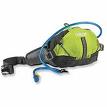
Shoes, bras, clothing, socks, watches, hydration pack.
The right shoes are absolutely essential to successful running. Finding the right running shoe means getting a proper shoe fitting and then finding the shoe that is right for your unique foot structure and stride. Some running stores have staff trained in the science and art of shoe fitting; seek out these stores. If you don’t have such a running store in your area, a Physical Therapist may also be able to assess your needs and suggest a running shoe. Provide the person fitting you with as much information about your running as possible; such as, how many miles a week you run, the distance you are training for, what type of surface you run on, any running injuries you may have had in the past, etc. The more background information a shoe professional has, the better.
The next most essential item for women runners is the proper sports bra. Again, the proper fit is necessary. Remember, running is a HIGH impact sport, so women need sports bras with maximum support.
All your running clothing should be made from high-tech fabrics that help wick sweat away from your skin, dry quickly, and are very lightweight. High-tech fabrics help prevent chafing and blisters too. Cotton fabrics are not ideal for running.
A running watch is a wonderful training tool. Timing your runs is a very good motivator. Seeing your times improve help keep you on the road. Not all watches have the same capabilities, so chose your watch carefully. First of all, make sure you can read the numbers!! If you are using the Galloway Run/Walk Method you will want a watch you can program for your run/walk interval. Once programmed, your watch will beep to tell you when to run and when to walk.
TIP #3: USE BODY GLIDE
Apply Body Glide any and everywhere that may possibly chafe: under your arms, under sports bras, between your thighs, on your feet, etc. The real secret to successful application is to turn your clothing wrong side out and apply Body Glide DIRECTLY to your clothing as well as your skin. Turn your socks wrong side out and apply Body Glide all over your sock as well as your foot, especially if it is raining!
TIP #4: HAVE A TRAINING PLAN
Select a specific distance to train for; a 5k training plan is very different than a marathon training plan, so select your goal distance first. After you have selected the distance, find a training plan that accommodates your goal and needs. There are many training plans that are 3 days a week. These programs are ideal for busy people and they are very effective. Training plans should include a track day, a tempo run or a hill run day, a long run day and a recovery day or days. Every run has an intention, or a purpose, directed toward helping you achieve your running goal.
TIP #5: HAVE A RECOVERY PLAN
Recovery is as essential to your training as is logging miles. Plan your recovery time just as you plan your runs. Most training plans will have at least one day a week OFF to allow muscles time to rebuild and replenish. Some training plans will also include easy run days or cross-training in addition to your training days. Sometimes less is more...adequate recovery time boosts your training. When you are fully recovered you are able to train more intensely; quality vs. quantity workouts.
TIP #6: ICE BATH ROUTINE
Ice baths are a great way to aid your recovery after long runs, races, or strenuous workouts. The purpose of taking an ice bath is too minimize the muscle inflammation that is usually present after some runs or races. First, fill the bath tub with cool water while you are sitting in the tub. You can wear a sweatshirt to keep your upper body warm. Fill the tub with enough water to cover your legs and hips. Next, slowly pour the ice in the tub, a 7-10 lb. bag is adequate. Stay in the water 10-20 minutes and then towel off. It helps to have a cup of hot tea or soup to sip on while sitting in the ice water. Your legs will thank you! DO NOT use heat for at least 48 hours after a race, long run, or strenuous workout.
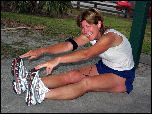
Stretch AFTER your runs! The best time to stretch muscles is when they are warm, so stretching after your run is preferable. Stretching a cold muscle can increase your risk of injury. Stretching elongates muscles that have tightened during your run, increases circulation, and improves range of motion. These benefits will aid and even speed up your recovery time between runs.
Warm up for your run by beginning slowly and gradually increasing your pace, rather than stretching. After your runs, create a stretching routine you will follow after every run. If you know you won’t stretch on your own, or if you are not sure of proper stretching techniques, take a stretching class. It is most important to find a routine that works for you.
TIP #8: LEARN TO LISTEN TO YOUR BODY!!!
Our bodies were designed for movement. Running is a very basic, perhaps even primal, activity. Use this time to get in touch with your body. Listen to your breathing patterns, feel your heart beat, assess your running form, hear your feet hit the pavement, swing your arms, notice any aches or pains, and tune in to your particular running rhythm. Free yourself from technology and learn to run by how you FEEL. Some days will be incredible, some days may not feel so good, but as you come to know yourself you will know when to push the pace and when to take it easy.
TIP #9: SAFETY
Always keep your personal safety in mind, run with a training partner if at all possible. At the very least, let someone know when and where you are
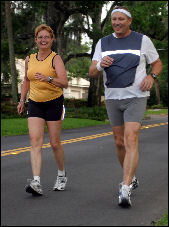
TIP #10: SET GOALS AND/OR RACES!
Most runners have found it is best to set their next goal or race BEFORE they complete the race they are currently training for now. Many runners experience a mild depression after they complete a race or accomplish a long-term goal. Training is very time consuming; marathon training is a 6-month effort before the race. After the race it is not uncommon to feel a little lost. What to do now with the extra time your training filled? For the past 6 months your life revolved around one goal and now it is over. One way to prevent this temporary lull is to register for another event, as long as you ALLOW YOURSELF RECOVERY TIME.
You don’t have to stick to one distance or venue. Choosing a shorter distance race, a triathlon, an adventure race, or targeting another marathon several months away continues your training focus, gives you a break, and allows you to keep your routine FUN
Use Facebook to Leave a Comment - We'd love to hear from you.


